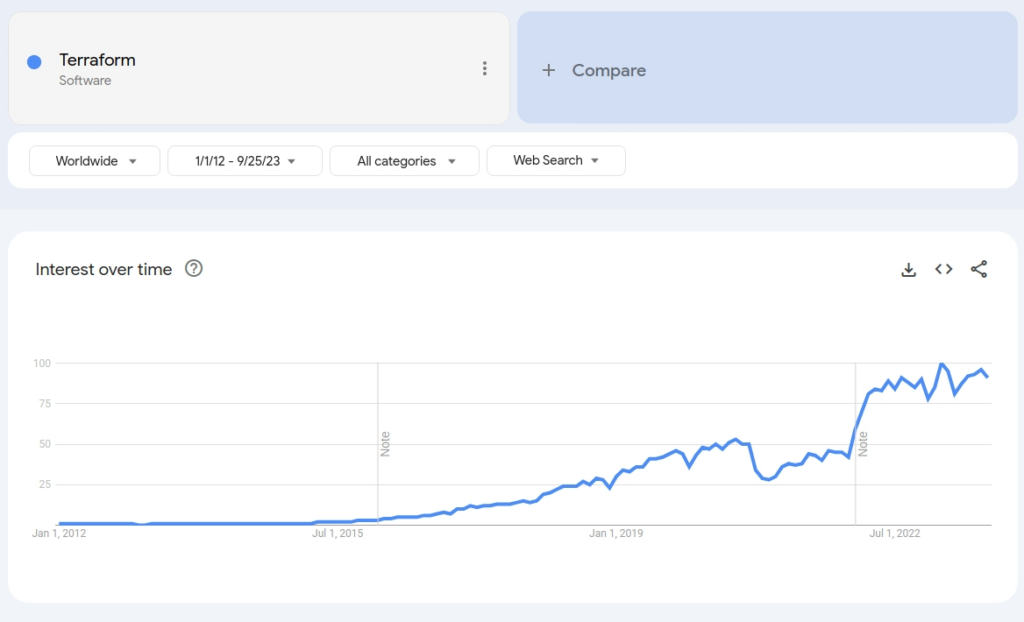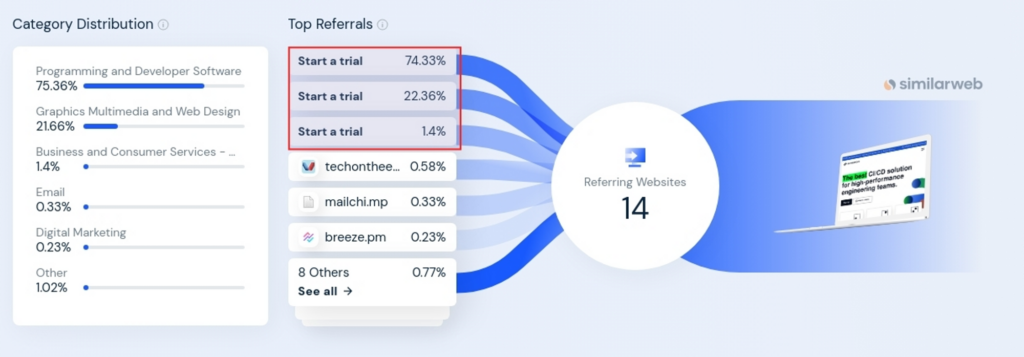TL;DR: In this article, we will discuss five key reasons why having a developer blog is crucial for success in the industry. These reasons include establishing thought leadership, driving organic traffic, promoting community engagement, enabling content marketing, and educating users. We will explore the benefits of having a developer blog and provide real-world examples of companies that have successfully implemented this strategy.
Establish Thought Leadership
In a technology landscape filled with similar offerings, establishing oneself as an authority is not an easy task, but it is entirely achievable.
A prime example is HashiCorp, a company that has attained thought leadership status through a proactive blogging strategy. By consistently publishing more than 10 articles per month and even increasing to a daily blog post during certain periods, they have successfully indexed over 18.6K keywords on search engines. This dedicated effort has yielded significant results, with over 50% of their website traffic now coming from organic sources. It is clear that their consistent and high-quality content has not only positioned them as thought leaders in cloud infrastructure automation but has also made them a go-to resource for developers seeking solutions to complex challenges.
The key takeaway? A developer blog is not just a nice addition; it is essential if you want to establish yourself as a leading authority in your field.
The success of HashiCorp doesn’t just lie in the effectiveness of their tools like Terraform; it’s also a testament to their brilliant content marketing strategy. While Terraform is undoubtedly a powerful tool for infrastructure automation, its widespread adoption in the developer community has been significantly bolstered by HashiCorp’s content efforts. From insightful how-to guides to in-depth case studies, HashiCorp has systematically used their developer blog as a platform to explain, promote, and expand upon the capabilities of their offerings.

The content serves a dual purpose: it educates potential users about the complexities and best practices of infrastructure automation, while also showcasing the utility of their tools in solving these complex problems. The articles serve as both educational resources and marketing assets, highlighting use-cases where Terraform and other HashiCorp tools can provide the most value.
Drive Organic Traffic
Driving organic traffic to your platform is crucial for ensuring sustained and substantial growth in the long run. One effective strategy to accomplish this is by establishing a developer blog, which can serve as a valuable asset in your overall marketing efforts. By regularly publishing informative and engaging content related to your platform, you can attract a wider audience and build a loyal community of developers and tech enthusiasts. This, in turn, can lead to increased visibility, brand recognition, and ultimately, more conversions and revenue for your business. Therefore, investing time and resources into creating and maintaining a developer blog can significantly contribute to the success and growth of your platform.
Take Semaphore, a CI/CD platform, as an excellent example. With over 350k monthly visits, a significant portion of their traffic comes from search engines, accounting for more than 50% of total visits. These impressive numbers are not just a stroke of luck; they are the result of a well-implemented content strategy.
Semaphore’s blog posts are shared on various platforms such as Reddit, Medium, and other content sharing plarforms, which expands their reach beyond search engine results. This widespread exposure results in a lower bounce rate of 73.3%, an average visit duration of over two minutes, and visitors exploring an average of 2.42 pages per visit. These statistics demonstrate that the content not only attracts visitors but also effectively engages them.
What is particularly striking is how these numbers translate into actual user actions. The majority of visitors come to the blog through search engines and are then guided through calls to action, such as “start a trial.” This creates a seamless journey from discovery to conversion.

Promote Community Engagement
Maintaining a developer blog provides a compelling opportunity to foster community engagement. It serves as a hub for meaningful interactions between your brand and your audience. A vibrant and regularly-updated blog creates opportunities for community building, encouraging passive readers to become active participants. By including comment sections, discussion boards, and user-generated tutorials and stories, you can create a more interactive and engaged community. This sense of belonging can ultimately turn casual visitors into loyal advocates, amplifying your brand’s reach and credibility.
Here are a few successful companies that are constantly engaging developers through regular content and blog posts:
- Stack Overflow Blog: Known for being a Q&A platform for developers, Stack Overflow also maintains a highly active blog. They encourage community contributions and often feature posts written by community members. This fosters a strong sense of belonging and encourages readers to actively participate in discussions.
- GitHub Blog: GitHub is not just a code repository; its blog serves as an engagement tool as well. They publish articles ranging from best practices in software development to feature releases and updates. The blog posts often lead to discussions and collaborations among community members, further solidifying GitHub’s role as a community hub.
- Discord Blog: Known for its real-time chat capabilities, Discord’s blog features community stories, feature updates, and developer interviews. These posts usually generate a lot of engagement, both on the blog itself and when shared on social media, further reinforcing its community.
- Mozilla Hacks: Mozilla’s developer blog covers in-depth topics that resonate with their community. Through open comment sections and the sharing of real-world use-cases of Mozilla’s technologies, they’ve been able to cultivate a community of engaged users who not only read but also contribute to discussions.
- Toptal: Toptal is a network of top freelance developers that also maintains a developer blog. They publish articles on various topics related to software development, providing valuable insights and resources for their developer community. The blog serves as a platform for knowledge sharing and community engagement. Toptal leverage its network of freelancers to write insightful and diverse articles that cover a wide range of development topics. From in-depth explorations of programming languages to industry best practices, the blog acts as a comprehensive knowledge base. By featuring content from their community, Toptal not only enhances its blog but also fosters a sense of ownership and engagement among its freelancer community. This dual-purpose approach amplifies Toptal’s credibility as a hub for top-tier development talent, while simultaneously creating an engaged and well-informed community.
Enable Content Marketing
A developer blog is not just a one-off project; it is a fundamental part of a larger content marketing strategy. Take companies like HubSpot or Shopify as examples. Their blogs serve as repositories of content that can be reused across different channels, from social media snippets to email newsletters. By consistently creating valuable blog posts, you can build a collection of content assets that can be used in various ways to reach a larger audience and achieve multiple marketing objectives. Essentially, a developer blog allows you to accomplish more with less, maximizing the return on investment (ROI) of your content efforts.
Educate and Onboard Users
Documentation is crucial, but it is often insufficient to fully educate users on how to maximize a platform. This is where a developer blog comes in. Companies like Atlassian complement their official guides with blog posts that include tutorials and FAQs. These extra resources help make the onboarding process smoother and keep existing users informed about new features and best practices. In summary, a developer blog can bridge the educational gaps, resulting in more satisfied customers and reduced churn rates.
A great example to highlight here is Twilio.
Twilio offers cloud communications APIs for SMS, voice, and more, targeting a largely developer-centric audience. Their blog serves as a treasure trove of developer resources, featuring tutorials, product updates, and use cases for their various APIs. But what sets them apart is their deep integration of community into their blog.
Twilio has a “Community” section where they highlight community contributions, including projects built using their APIs, developer stories, and even “Twilio Champions”—a recognition program for community members who have gone above and beyond to help others in the ecosystem. They actively encourage readers to share their own stories and projects, and they often feature these contributions on the blog, which in turn encourages more community members to participate.

By doing so, Twilio’s blog not only serves as an educational platform but also as a community-building tool. They have successfully created an engaged developer community around their product offerings, which significantly enhances brand loyalty and amplifies word-of-mouth marketing.
Twilio’s approach to community engagement through its developer blog is unique and interesting. We can summarize it in 8 points:
- Practical, Hands-On Tutorials: Twilio’s blog posts often provide detailed, hands-on tutorials that guide developers through building specific projects. This valuable content positions Twilio as a practical resource for learning and problem-solving.
- Cross-Platform Integration: Many of Twilio’s blog posts teach users how to integrate Twilio services with popular platforms and technologies such as WhatsApp, AWS, Notion, and GitHub. This demonstrates the flexibility and interoperability of Twilio’s products, appealing to a wider audience.
- Use-Case Diversity: Twilio showcases the diverse applications of their services, from tracking football games to building an AI personal trainer. This expands the potential user base who might consider Twilio’s services for various projects.
- Timely and Relevant: Some posts, such as reading top live news headlines, tap into the current interest in real-time data and information. This makes the blog—and by extension, Twilio’s services—feel current and relevant.
- Multi-Channel Engagement: Twilio’s posts discuss integrating with various communication channels like SMS, Voice, and MMS, showcasing the multifaceted capabilities of their platform.
- Language and Framework Inclusivity: The posts include tutorials in different programming languages and frameworks, broadening their appeal to developers with different skill sets.
- Clear Calls-to-Action: The tutorials naturally lead users to consider using Twilio’s services, driving conversions through effective, subtle calls-to-action embedded in the content.
- Promotion of Auxiliary Services: Twilio also uses its blog to promote other services they offer, such as SendGrid for email, expanding the reach of their content marketing.
What’s next?
Having a developer blog is crucial for software and developer tools companies. It allows them to establish thought leadership, drive organic traffic, promote community engagement, enable content marketing, and educate users. By incorporating a developer blog, companies can build their brand, attract a wider audience, engage their community, and provide valuable resources. It is a powerful tool for long-term growth and success.
If you’re looking to establish or optimize a developer blog that resonates with your target audience, look no further! At MarketToDev, we specialize in crafting compelling content that drives action. Click the button below to schedule a free consultation and learn how we can elevate your developer relations and marketing strategy.


Leave a Reply